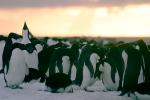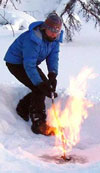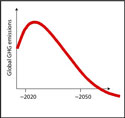
Australian-born writer Meredith Hooper was looking for “a route into the complex business of the Earth’s changing climate” when she spent January to March 2002 at Palmer Station on the west coast of the Antarctic Peninsula. She watched and chronicled the work of scientist Bill Fraser and his team who for years have studied the Adélie penguins breeding on nearby islands over the summer months.
I read the account of her time there in her book The Ferocious Summer. It was the summer when the Larsen B ice shelf on the eastern side of the Peninsula spectacularly disintegrated. Her often poignant story tells of diminished numbers of penguins arriving for breeding, weather conditions inappropriate for their nesting, poor nutrition levels and low fledgling survival rates.
The book was also an illuminating account of the working and thinking of the scientists as they gradually amass and interpret the years of data needed for a proper understanding of what is happening to wildlife populations under the inexorable processes of climate change.
Hooper wrote for any who want to understand what global warming might mean for specific places and the life which has developed in close relationship with them. She observes that “climate change isn’t a blanket thrown evenly over the surface of the Earth”. Its impacts are variable and often need to be understood locally.
In the vulnerability of the Adélie penguins she saw a small example of a potentially vast reality ahead. “In one sense, they had become surrogate humans.” Her book was yet another solemn warning from the world of science.
Now another book has appeared by a writer who also spent several months with Bill Fraser’s team. Fraser’s Penguins is written by Fen Montaigne, senior editor of the online Yale 360. I hope to be reading and reviewing it in the near future. But in the meantime I wanted to draw attention to a report he has just written for Yale 360, The Warming of Antarctica: A Citadel of Ice Begins to Melt. Its focus is much wider than the Adélie penguins, though they figure in it: amongst other things he notes that their population has declined from 30,000 breeding pairs in 1975 to 5,600 pairs today.
On the broader Antarctic picture Montaigne explains helpfully for the general reader the developing scientific understanding of the effects of warming on the ice. He begins with a prescient quote from a geologist, John H. Mercer, writing in Nature in 1978.
“If present trends in fossil fuel consumption continue, a critical level of warmth will have been passed in high southern latitudes 50 years from now, and deglaciation of West Antarctica will be imminent or in progress… One of the warning signs that a dangerous warming trend is under way in Antarctica will be the breakup of ice shelves on both coasts of the Antarctic Peninsula, starting with the northernmost and extending gradually southward.”
Montaigne observes that Mercer’s prediction has come true, a couple of decades earlier than he anticipated. Since Mercer wrote those words eight ice shelves have fully or partially collapsed along the Antarctic Peninsula, and the northwestern Antarctic Peninsula has warmed faster than virtually any place on Earth.
Montaigne continues:
“The question now, as humanity pours greenhouse gases into the atmosphere at an accelerating rate, is not whether Antarctica will begin to warm in earnest, but how rapidly. The melting of Antarctica’s northernmost region – the Antarctic Peninsula – is already well underway, representing the first breach in an enormous citadel of cold that holds 90 percent of the world’s ice.
He acknowledges the vastness and coldness of the Antarctic ice dome, the heart of which is not likely to begin to melt any time soon. But the periphery is another matter, and on that periphery the Antarctic peninsula has warmed faster than any other place. A 60-year temperature record at a research base on the northwest shows winter temperatures 11 degrees F higher and annual average temperatures 5 degrees F higher.
Ninety percent of 244 glaciers along the western Antarctic Peninsula have retreated since 1940. Sea ice covers the Southern Ocean off the western Antarctic Peninsula three fewer months a year than in 1979, according to satellite data. In addition, ice shelves have been disintegrating up and down the peninsula.
He quotes Ted Scambos, the lead scientist at the National Snow and Ice Data Center in Boulder, Colorado.
“We are already at the point where the changes we’re seeing in this part of Antarctica are unprecedented throughout the entire period of human civilization.”
Turning to the Pine Island and Thwaites glaciers further south, Montaigne discusses the effect of warming water. Changing atmospheric and oceanic circulation patterns have caused the water of the deep Antarctic Circumpolar Current to be funnelled up onto the continental shelf in western Antarctica. At 37 degrees F in winter, it is warmer than the surface water and much warmer than air temperatures. It’s a huge volume and is having an enormous impact. In relative terms it is described as “blisteringly hot” by Douglas Martinson, an oceanographer and Antarctic specialist at Columbia University’s Lamont-Doherty Earth Observatory.
The thinking of Robert Bindschadler, a senior fellow at the Goddard Space Flight Center and an expert on Antarctic ice, is that the warmer waters are melting the submerged undersides of the ice shelves attached to the Pine Island and Thwaites glaciers, causing them to grow thinner. The melting is effectively loosening the grip of the Pine Island Glacier on the sea floor, causing the vast river of ice behind it to accelerate into the sea. It is now moving at a rate of about two miles a year.
Montaigne reports Bindschadler as saying that if all the ice from the ice streams feeding the Pine Island and Thwaites glaciers were to flow into the Southern Ocean, global sea levels could increase by five feet, inundating low-lying coastal areas from Florida to Bangladesh. “Such an event, said Bindschadler, “could happen in the next half-century.”
The warming of the Antarctic is already bad news for ice-dependent penguin species. It will also be bad news for humanity if we mindlessly continue our assault on the citadel of ice.
Like this:
Like Loading...
 Atmospheric methane levels continued to increase in 2009, the World Meteorological Organisation’s annual Greenhouse Gas Bulletin (summary PDF) confirmed this week. Methane averaged 1803 ppb over the year, up 5 ppb on 2008, and now contributes 18.1% of the radiative forcing caused by current greenhouse gas levels. The Bulletin suggests that “likely causes were above average wetland methane emissions due to exceptionally warm temperatures at high northern latitudes in 2007 and heavy precipitation in tropical wetlands in 2007 and 2008. However, it cautions that the reasons for the recent increases are not yet fully understood.”
Atmospheric methane levels continued to increase in 2009, the World Meteorological Organisation’s annual Greenhouse Gas Bulletin (summary PDF) confirmed this week. Methane averaged 1803 ppb over the year, up 5 ppb on 2008, and now contributes 18.1% of the radiative forcing caused by current greenhouse gas levels. The Bulletin suggests that “likely causes were above average wetland methane emissions due to exceptionally warm temperatures at high northern latitudes in 2007 and heavy precipitation in tropical wetlands in 2007 and 2008. However, it cautions that the reasons for the recent increases are not yet fully understood.”


